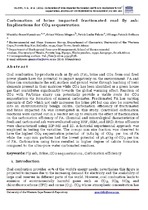| dc.contributor.author | Muriithi, Grace | |
| dc.contributor.author | Gitari, Wilson | |
| dc.contributor.author | Petrik, Leslie | |
| dc.contributor.author | Ndungu, Patrick | |
| dc.date.accessioned | 2013-10-15T14:21:51Z | |
| dc.date.available | 2013-10-15T14:21:51Z | |
| dc.date.issued | 2011 | |
| dc.identifier.citation | Muriithi, N.G., et al. (2011). Carbonation of brine impacted fractionated coal fly ash: Implications for CO2 sequestration. Journal of Environmental Management, 92(3): 655-664 | en_US |
| dc.identifier.issn | 1654-7209 | |
| dc.identifier.uri | http://hdl.handle.net/10566/757 | |
| dc.description.abstract | Coal combustion by-products such as fly ash (FA), brine and CO2 from coal fired power plants have the potential to impact negatively on the environment. FA and brine can contaminate the soil, surface and ground water through leaching of toxic elements present in their matrices while CO2 has been identified as a green house gas that contributes significantly towards the global warming effect. Reaction of CO2 with FA/brine slurry can potentially provide a viable route for CO2 sequestration via formation of mineral carbonates. Fractionated FA has varying amounts of CaO which not only increases the brine pH but can also be converted into an environmentally benign calcite. Carbonation efficiency of fractionated and brine impacted FA was investigated in this study. Controlled carbonation reactions were carried out in a reactor set-up to evaluate the effect of fractionation on the carbonation efficiency of FA. Chemical and mineralogical characteristics of fresh and carbonated ash were evaluated using XRF, SEM, and XRD. Brine effluents were characterized using ICP-MS and IC. A factorial experimental approach was employed in testing the variables. The 20–150 μm size fraction was observed to have the highest CO2 sequestration potential of 71.84 kg of CO2 per ton of FA while the >150 μm particles had the lowest potential of 36.47 kg of CO2 per ton of FA. Carbonation using brine resulted in higher degree of calcite formation compared to the ultra-pure water carbonated residues. | en_US |
| dc.language.iso | en | en_US |
| dc.publisher | Elsevier | en_US |
| dc.rights | This is the author postprint version of an article by Elsevier. The file may be freely used, provided that acknowledgement of the source is given. | |
| dc.source.uri | http://dx.doi.org/10.1016/j.jenvman.2010.10.008 | |
| dc.subject | Fly ash | en_US |
| dc.subject | Brine | en_US |
| dc.subject | CO2 sequestration | en_US |
| dc.subject | Carbonation efficiency | en_US |
| dc.title | Carbonation of brine impacted fractionated coal fly ash: Implications for CO2 sequestration | en_US |
| dc.type | Article | en_US |
| dc.privacy.showsubmitter | false | |
| dc.status.ispeerreviewed | true | |
| dc.description.accreditation | Web of Science | en_US |

